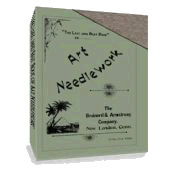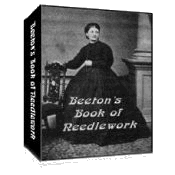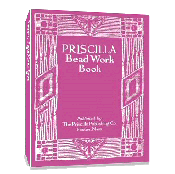Victorian Draperies
Victorian draperies often create a dilemma for home decoration today. Most people think of heavy, multi-layered drapes with lace undercurtains when they think of Victorian style. While this style can be accurate, this style was not always in vogue during the Victorian era. Victorian drapery became more elaborate as the Victorian era progressed into the 1880s. In the late 1880s and early 1890's, a simpler style became the fashion. Victorians began to streamline the decorating of their homes. This movement from super fancy and frilly to more subdued was called the aesthetic movement. Window drapery treatments became much simpler.
The following information was published in 1890 to advise ladies on window treatments. Illustrations and instructions have been included when possible.
ALTHOUGH heavy curtains and cumbersome draperies made up so elaborately as to form receptacles for dust are no longer in vogue, Fashion and good sense unite in paying considerable attention to the curtaining and draping of windows. Charming effects are produced without large outlay. India silk, plush, scrim, and Madras are among the materials which are oftenest selected for draping and curtaining, and it is safe to say that the simpler textures are susceptible of quite as artistic treatment as the richer fabrics. Here are a few things which purchasers should bear in mind in selecting window draperies:
- That very cheap lace curtains are less desirable than those of scrim or muslin.
- That any lady who is clever with her needle can make handsome window curtains.
- That she must take every stitch and mea-sure every part with precision if she hopes to win approval for her work.
- That fluted ruffles are very pretty upon cottage curtains, but that they should be full enough to flute evenly.
- That the narrow margin projecting beyond the work upon lace curtains should be hemmed under or moistened with gum arabic water and pressed underneath, but not cut off.
- That dark heavy curtains may make a large room look cozy, but they decrease the apparent size of a small room.
- That lace curtains - unless they be of the finest quality - always hang a little stiff when first put up.
- That they will fall into more graceful folds after a short time.
- That they should either be draped back, or allowed to fall straight permanently. Frequent changing stretches them.
- That the extra length should be folded in and- in at the top - not allowed to drag upon the floor - never cut off, as it will be needed when the curtains are laundered.
- That écru and all shades of cream and gold are obtainable in lace curtains, but that it is always safe to select a pure white tint in fine curtains.
- That the effect of a narrow window may be broadened and a low one heightened by having the poles extend beyond it, or placing them a little above it.
- That a curtain or shade which is worked on rollers should not be jerked or drawn side-ways, if its easy and satisfactory management is to be perpetuated.
Below you will find information and illustrations on a Victorian drapery style that became very popular during the aesthetic movement.
Victorian Draperies
A full drapery of Madras is often placed before the lower part of the window when the room is on the ground floor and a certain amount of privacy is desired. The curtain drapery is then hung from the top of the window and falls over the Madras. It is mounted on its rod, and, being in two parts, may, therefore, be pushed aside to permit the light to stream in. The material is felt of a dull mode color, and the velvet band is of a golden-brown shade; while the background of the appliquéd figure is velvet of the same color and the pansies of yellow silk are selections from manufactured silk floral appliqués. One need not necessarily be an adept at needle-work in order to be able to make such a drapery. The lining is of brown sateen. Of course, individual taste will dictate other combinations, but the colors mentioned are most in vogue and are of a variety of which the eye will not soon weary.
Appliqué for Victorian Draperies
The flat appliqué here pictured shows the design of those decorating the window drapery pictured above. The appliqué measures 3 inches across. It is of yellow silk, and the flower is well brought out by the golden-brown velvet background. These flowers may be utilized well brought out by the golden-brown velvet background. These flowers may be utilized for all decorative purposes and will be found desirable on rugs for lounges, on crazy quilts,and, indeed, any of the numerous "bits" that seem to call for embroidered ornamentation.
Victorian Window Drapery #2
Decorated Curtain
This curtain is made of écru linen, its deep hem having above it three rows of feather-stitching done in very heavy scarlet crewels. The daisies, graded as illustrated, are of scarlet and white in the long outline-stitch usually chosen for them.
The cord and tassels are of scarlet and white, looped through the brass crescents in an artistic manner. Dark brown and yellow, blue and yellow, or all crimson crewels may be used if preferred to the colors illustrated.
Although decorators in the Victorian era deemed certain styles better than others, and the aesthetic movement did have many followers, not everyone followed the current fad. Many Victorians liked, and kept, the luxurious draperies they had become accustomed to. Many others, who did follow the aesthetic movement and did make changes in their household décor, kept the multi-layer currents in vogue years before. Victorian draperies would and will forever be remembered and admired for the extravagant beauty they brought to a home.
If you don't have time or feel making your own Victorian draperies are beyond your skill set, you can always purchase some that will fit your needs. Take a look below:
For more information, illustrations, and designs for Victorian Draperies, see the following pages:
Return to top of page.
Return to Victorian Home Decor page.
Return from Victorian Draperies page to Home.



 433 pages!
433 pages!

